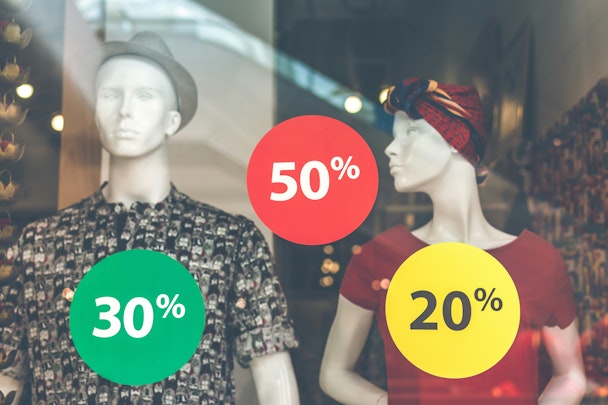Livestream shopping is huge in APAC, but is it ready to take the world by storm?
Influencers in APAC can already shift vast amounts of inventory in mere moments. The Drum Network asked four experts whether live-selling will soon revolutionize e-commerce in the US and Europe.

The success of live-selling often relies on influencers being able to offer big discounts. / Artem Beliaikin via Unsplash
Consumers in APAC have long logged on to social media to make purchases via live-stream shopping feeds. Leading influencers shift vast amounts of products – with ‘Lipstick Brother’ Li Jiaqi selling a record-breaking $2bn of goods in one day in 2021.
But while social media platforms in the US and EMEA offer services such as TikTok Live and Instagram Live Shopping, uptake still lags behind that in APAC.
It’s estimated half of China’s internet users participated in a live-selling event last year. In the US, around 35% of respondents to a survey said they’d purchased something from a live stream event, a figure which stood at 25% for UK respondents.
“Live streaming sessions in China have been really, really successful,” said Ada Luo, head of APAC at Croud at a roundtable hosted by The Drum last year, “But it didn’t happen overnight. Actually, it’s taken seven years of development and experience to be able to reach today. [In 2022] sellers generated almost $500bn in transactions just during live-selling sessions. But, the Alibaba Group first brought in the concept in 2016.”
There are several barriers though to comparative figures being reached in the US and Europe. Not least the cost of driving online traffic at scale, the established nature of relationships between brands and their customers, and pre-existing pricing agreements.
Concerns about convenience and tone of voice
Katie Anscombe, director of planning at M&C Saatchi Performance, said live-selling felt a bit like “QVC on steroids,“ adding she had doubts over whether it could replicate the same success in western markets, worrying that luxury brands in particular might have concerns around tone of voice.
However, in these markets, Anscombe does think that consumers can be convinced to spend money on livestreams in particular conditions: with brands they already know, and where a good deal is to be had.
“From a consumer perspective, that would be really attractive to me: the idea of getting a great deal obviously is attractive… If it was a makeup brand that I'd heard of and liked, and I saw a live stream, and I could negotiate a price down and snap it up for cheap. But would I do that with a brand I didn’t know very well?”
Graham Lubie, vice president of digital design & technology at Wasserman, says that while many clients are still tentative in their approach to live-selling, “more asynchronously” video selling was an important tool alongside traditional methods.
“If somebody wants to consume content about a product and get it from referrals, it’s not that they have to sign on to a specific live stream at say two in the afternoon,” he said. “They can sign on anytime they like.”
Clients embrace omnichannel selling
Sarah Fritz, senior digital strategist at Momentum Worldwide, describes a substantial brand appetite to leverage omnichannel commerce, "across both live streams as well as more traditional e-commerce platforms. And more established retailers like Amazon, but also a few specialist retailers.”
Luo explains that a big draw to live-selling for shoppers in China is the strong assumption that they give the cheapest possible price. Influencers, she says, make deals with brands who often sacrifice margin in return for the amount of inventory the likes of Lipstick Brother Li, or “live-streaming queen” Huang Wei – more commonly known as Viya – can shift.
Lubie says, though, that he can imagine live-selling having a different appeal in the US particularly. “I can certainly envision scenarios where you have exclusive drops, for brands, where there is a time-definite opportunity for for customers to buy limited edition and limited edition products in limited quantities.
"In that scenario, shoppable media can definitely work, because you're giving customers the opportunity to come in and buy and you can potentially reduce your inventory very quickly. And it's not necessarily going to be at a discount; it could, in fact, be at a premium, because it's a premium product, and it has limited availability.”
All that glitters is not gold
There was a consensus among the four participants of the roundtable, which took place in 2023, that while barriers still exist to widescale adoption of live-selling in the US and UK, it could also be incorporated as part of a spectrum of different commerce methods.
Luo argues, for example, that while the maturity of the industry, and the technology that enables it, in APAC, as well as the carefully crafted pricing strategies, had led to a booming industry, it might not necessarily be “healthy” that the best-known sellers had the power to drive down prices.
“You actually have to pay a deposit to get into [one of the live-selling sessions] ahead of time," she said. "And you have to be able to negotiate as well, in terms of the lower price that you can give to the influencer, and sometimes even ignoring how much margin you're going get because you can sell so much product.”
In one case, Luo says, a high-profile seller had even blacklisted a brand after discovering it was offering its products cheaper elsewhere.
Content created with:

Croud
Croud is a global, full-service digital agency that helps businesses drive sustainable growth in the new world of marketing. With a rich heritage in performance,...
Find out more
M&C Saatchi
Our business is based upon four defining principles which we all live by, whether it be in the work we do or how we run this incredible business.
Brutal Simplicity...

Wasserman
Wasserman is a global sports, entertainment, and lifestyle marketing agency with expertise in creating connections between brands, properties, talent, and consu...
Find out more
Momentum Worldwide
Momentum Worldwide has a proud history of creating industry-first experiences that authentically place brands in the cultural conversation. 1,000+ individuals across...
Find out more
